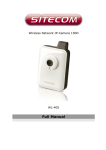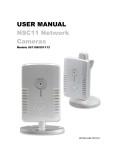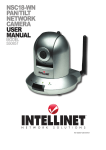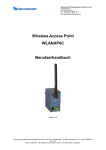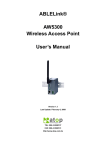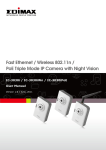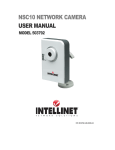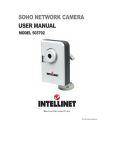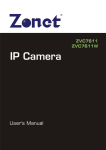Download AirLink AIC600W (5 Pack)
Transcript
ConnectSky™600W Wireless N MPEG4 Network Camera Model # AIC600W User’s Manual Ver 1.0 Table of Contents Chapter 1: Familiar with your Internet IP Camera ................................................................. 4 1.1 Package Contents..................................................................................................... 4 1.2 Basic Introduction ................................................................................................... 5 1.3 Product Highlights................................................................................................... 6 1.4 Familiar with Key Components ............................................................................... 7 1.5 Camera Installation.................................................................................................. 9 Chapter 2: Using Web Management Interface...................................................................... 15 2.1 Camera Settings..................................................................................................... 15 2.1.1 About .......................................................................................................... 17 2.2 LAN Settings......................................................................................................... 18 2.2.1 IP Address................................................................................................... 18 2.2.2 RTSP .......................................................................................................... 20 2.2.3 Dynamic DNS............................................................................................. 21 2.2.4 UPnP .......................................................................................................... 22 2.2.5 LoginFree ................................................................................................... 24 2.3 WLAN................................................................................................................... 25 2.4 Video..................................................................................................................... 30 2.4.1 Dual Mode .................................................................................................. 31 2.4.2 MPEG4....................................................................................................... 32 2.4.3 MJPEG ....................................................................................................... 33 2.5 Email & FTP ......................................................................................................... 34 2.5.1 Email Settings............................................................................................. 34 2.5.2 FTP Settings................................................................................................ 35 2.6 Motion Detection................................................................................................... 37 2.6.1 Basic Settings.............................................................................................. 37 2.6.2 Setup Motion Detection Regions................................................................. 38 2.7 Schedule Snapshot................................................................................................. 40 2.8 System................................................................................................................... 41 2.8.1 Camera Information .................................................................................... 41 2.8.2 Date / Time Setting ..................................................................................... 42 2.8.3 Utilities ....................................................................................................... 43 2.9 Status..................................................................................................................... 45 2.10 Account ............................................................................................................... 46 2.11 Log ...................................................................................................................... 48 Chapter 3: ConnectSky™ Viewer........................................................................................ 49 3.1 Software Installation.............................................................................................. 49 3.2 Using ConnectSky™ Viewer ................................................................................. 51 3.3 Configuring ConnectSky™ Viewer........................................................................ 54 3.3.1 Configure Cameras ..................................................................................... 54 3.3.2 General Settings.......................................................................................... 63 3.4 Change Display Layout ......................................................................................... 68 3.5 Full-screen mode ................................................................................................... 71 3.6 Scan....................................................................................................................... 72 3.7 Snapshot................................................................................................................ 73 3.8 Recording .............................................................................................................. 74 3.9 Video Playback...................................................................................................... 75 Chapter 4: Appendix ........................................................................................................... 76 4.1 Specification.......................................................................................................... 76 4.2 Troubleshooting..................................................................................................... 78 Technical Support ............................................................................................................... 81 Chapter 1: Familiar with your Internet IP Camera 1.1 Package Contents Before you start to use this network camera, please check the package contents. If anything is missing, please contact the dealer of purchase and return the package to claim for missing contents. Item Name Quantity 1 Wireless N MPEG4 Network Camera AIC600W 1 2 Power Adapter 5V/1A 1 3 Ethernet Cable 1 4 Quick Installation Guide 1 5 Installation CD 1 6 Wall Mount 1 1.2 Basic Introduction Thank you for purchasing ConnectSky™600W Wireless MPEG4 Network Camera! This network camera AIC600W is an ideal product for all kinds of video-surveillance purposes, like home/office safety, kid/pet monitoring, and remote video acquire etc. Unlink conventional close-circuit vide camera, you’re not limited to the length of cable! Once this camera is connected to Internet, you can receive video from anywhere in the world where Internet access is available. If you have problem installing a new cable from the place the camera is installed to your monitoring computer, don’t worry! We also provide wireless version which supports wireless network, that is, you can link to this camera wirelessly! You only have to provide this camera with 5V power by the power adapter that comes with the product package, and you don’t have to set a new network cable between the network camera and monitoring computer. Worry about the content will be intercepted by unauthorized person when the video is transmitted over the air? That’s also not a problem! Unlink conventional analog wireless camera, which video will be intercepted by anyone who got a compatible video receiver, this network camera supports data encryption (WEP & WPA), which will provide ultimate data security level. All video transmitted over the air is encrypted; therefore no one will be able to get the video captured by the camera, expect yourself. If you’re not familiar with wireless security setting, this camera also support WPS (Wi-Fi Protected Setup), which allows you to setup wireless security in a very simple way - just press a button or input a 8-digit number. You can discover more useful functions in next section! 1.3 Product Highlights • No pre-loaded software required - all you need is a browser like Internet Explorer 6 (and above, with plugin installed). • Supports VGA (640 x 480), QVGA (320 x 240), and QQVGA (160 x 120) video resolution. • • Supports two video compression format (MJPEG and MPEG4). Wired and wireless network (802.11b / 802.11g / 802.11n) support. • Wireless data encryption (WEP / WPA). • WPS (Wi-Fi Protected Setup), the easiest way to setup a secure wireless connection. • Supports DHCP and you can also assign a fixed IP address to the camera also. • Supports Dynamic DNS (used to allocate the IP camera’s Internet address, when the ISP you’re using does not assign you with a fixed Internet address). • Supports UPnP, Windows XP (and above) will discover this IP camera in network neighbor automatically. • • Send captured picture by Email or FTP when motion is detected. Configurable motion detection sensitivity (6 levels from most sensitive to least sensitive). • Built-in real-time clock, date and time information will be recorded with every captured picture / video clip (also supports auto time synchronization via network time protocol). • • • Upgradeable firmware - enjoy new functions without buying a new camera! Supports up to 4 users, and you can set different password to different user. Usage and event logging. 1.4 Familiar with Key Components Front Panel LEDs LED Power / WPS Link Color Light Status Description On The device is powered on. Off The device is powered off. Blue Green Slow Blinking Camera is booting Quick Blinking Camera is waiting for WPS connection On Camera is connected to network. Off Camera is not connected to network. Flashing Camera is logged in by user. Back Panel Item Name Description Antenna 2.4GHz Wireless Network Antenna Tripod Connector Connects to any standard tripod / camera wall holder. Reset / WPS Press and release this button to activate WPS mode; press and hold this button for 10 seconds to go back to factory default. LAN Connects to LAN by Ethernet cable. Power Power connector, connects to A/C power adapter. 1.5 Camera Installation Please follow the following instructions to set up your IP camera. Step 1 Connect the power adapter to the Internet Camera and plug the power adapter to power outlet. When the camera is ready, the Power LED will be lit. Step 2A If your router has a built in Easy Setup Button (WPS button), you can easily build the wireless connection between your router and the camera. If your router doesn’t have a built-in WPS button, please go to Step 2B. 1) Push the WPS button on the back of the camera and hold for 1 second. 2) Push the WPS button on the router. 3) The wireless connection between the camera and your router will be built within 1 minute. 4) Continue to Step 3. Step 2B Connect the Internet Camera to your network by attached the network cable from the switch/router to the LAN port of the Internet Camera. Step 3 Insert the provided CD into your computer’s CD ROM drive. The “autorun.exe” program should be executed automatically. If not, run “autorun.exe” manually in the CD. Step 4 Click Install ConnectSky™ Setup Wizard. Step 5 Follow the on screen instructions to install the Setup Wizard. Step 6 After the installation finished, the ConnectSky™ Setup Wizard will launch up. If not, double click on the icon on your desktop: Step 7 Click on Search Camera to show the camera(s) connected to your network. If you do not see any camera in the list, try Step 2 again. Step 8 Select the camera you wish to view/configure and click Browse Camera via Web. Note: By default, AIC600W uses dynamic IP address. If there is no DHCP server in your network or you prefer to use static IP address, you may click Configure Camera to change the IP settings. Step 9 Enter ‘admin’ for both user name and password. Step 10 Click on Install to install the plug-in for the camera. Step 11 Click on the white box to install ActiveX control in order to view the camera image. Step 12 You should now be able to view the image. Note: If you did Step 2A, your camera has connected to you wireless network already, and you do not need any further configuration to start using your camera. If you did Step 2B, please continue the following steps to configure the wireless settings. Step 13 Click on WLAN on the top menu bar to enter the Wireless LAN page. Step 14 Follow the steps below: 1) Select the wireless network you wish to connect to 2) enter the wireless Key below if your wireless network is encrypted 3) click Apply. 3 1 2 Congratulations! The configuration is now complete. You can disconnect the Ethernet cable from the camera and move it to the desired location. Chapter 2: Using Web Management Interface 2.1 Camera Settings The first menu after you logged onto web management interface is ‘Camera’, and this is the only menu you can see the real-time image from camera. You can always back to this menu by clicking ‘Camera’ on the top of web management interface. The descriptions of every setting in this menu will be given below: Item Description Video Format Specifies video encoding format. You can choose MPEG4 or MJPEG (Motion-JPEG). MPEG4 mode also supports motion detection (see chapter 2.2.1). Snapshot Take a snapshot picture and save the picture to your computer’s hard drive. Click on directory display and you’ll be prompted to select a folder to save snapshot file. Record Start video recording and save recorded video clip to your computer’s hard drive. Click on directory display and you’ll be prompted to select a folder to save snapshot file. Full Screen Click this button and the image captured by camera will be displayed in full-screen mode. To resume, double-click the image. Digital Zoom Click this button to enable digital zoom (video magnification) function: Check ‘Enable’ box to enable digital zoom, and you can set the percentage of zoom from 100% (no magnification) to 400%. You can also drag the green square by mouse and put it on the area you wish captured image to be magnified. Fit to Window To exit digital zoom setting, press button. Click this button and captured image will fit to window size. 2.1.1 About This function will provide you with the version number of current IP camera plugin, which is useful when you need online support. To see version information, right-click on the image. A pop-up menu will appear: Select ‘About’ and the version information will appear: 2.2 LAN Settings All network-related settings can be found in this menu, and you have to specify TCP/IP parameters in this menu if you want to change IP address, use PPPoE, Dynamic DNS, and activate UPnP function. You can access this menu by clicking ‘LAN’ on the top of web management interface. 2.2.1 IP Address You can define IP address and select the port number you wish to use here. The descriptions of every setting in this menu will be given below: Item Description Network Type This camera can obtain the IP address from DHCP server automatically (i.e. Router), or set a fixed IP address. Select ‘DHCP’ to obtain IP address automatically or ‘Static IP Address’ to assign this IP camera with a fixed IP address. ‘DHCP’ is enabled by default, so it is suggested to run the ConnectSky™ Wizard to locate the camera and then assign a fixed IP address to it. IP Address Specify the IP address for this IP camera here. The camera’s default IP address is ‘192.168.2.240’. Subnet Mask Specify the subnet mask for this IP camera here. Gateway Specify the gateway address of the local network here. Primary DNS Specify the IP address of DNS server here. Please input IP address only. If you don’t know the address of DNS server, ask network administrator or your ISP for help. Secondary DNS Specify the IP address of backup DNS server here. When primary DNS is unreachable, IP camera will use the IP address specified here as DNS server. This field is optional. AV Control Port Specify the port number of video transfer here. If you have firewall on your network, you need to allow computers on Internet to access this port number of the IP address of IP camera, or you’ll not be able to view video from Internet. HTTP Port Specify the port number of web management interface here. If it’s not 80, you’ll have to add ‘:port’ after the IP address / hostname of this IP camera. For example, if the HTTP port number you specified here is 90 and the IP address of IP camera is 10.20.20.30, then you have to input ‘http://10.20.20.30:90’ in the address bar of Internet explorer. Click ‘Apply’ to save settings and make the new settings take effect. 2.2.2 RTSP RTSP (Real-Time Streaming Protocol) allows you to view live video captured by IP camera. You can set RTSP related settings here. The descriptions of every setting in this menu will be given below: Item Description Enable RTSP Select ‘Enable’ to activate RTSP function of this IP camera, select ‘Disable’ to disable it. RTSP Port Input the port number which RTSP will use. Default setting is 554. RTSP Path Input the path of RTSP stream. ** RTP Port Range Input the port range of RTP. Default setting is 50000 to 60000. Click ‘Apply’ to save settings and make the new settings take effect. 2.2.3 Dynamic DNS If your ISP does not give you a fixed Internet IP address (i.e. the Internet address you’re using when you access the Internet is not always the same – ask your ISP for detailed information), you can use this function to help you locate the IP address of this IP camera when you’re away from home or office. Before you can use this function, you’ll need to apply for an account at dyndns.org (http://www.dyndns.org). Detailed instructions of how to apply a new account can be found on dyndns.org’s website. The descriptions of every setting in this menu will be given below: Item Description Enable DDNS Select ‘Enable’ to activate Dynamic DNS function of this IP camera, select ‘Disable’ to disable it. Provider Select dynamic DNS service provider here. Only dyndns.org is available currently. Host Name Input dynamic DNS host name here. User Name Input dynamic DNS user name here, must be the same as the one you applied on dyndns.org. Password Input dynamic DNS password here, must be the same as the one you applied on dyndns.org. Click ‘Apply’ to save settings and make the new settings take effect. 2.2.4 UPnP When UPnP function is activated, all UPnP-compatible computers / network devices will be able to discover this IP camera automatically (only those in the same local network). This function is useful and you don’t have to remember the IP address of this IP camera. Simply open ‘Network neighbor’ and it’s there! The descriptions of every setting in this menu will be given below: Item Description Enable UPnP Select ‘Enable’ to activate UPnP function of this IP camera, select ‘Disable’ to disable it. Click ‘Apply’ to save settings and make the new settings take effect. After UPnP function is activated, a popup message will appear: Click the message to open ‘My Network Places’, and you’ll see the IP camera: You can double-click the icon to launch Internet Explorer and log onto IP camera’s web management interface directly. 2.2.5 LoginFree You can specify a filename here, and everyone who know this filename can gain access to the picture captured by the IP camera with this name with .jpg file extension. For example, if the filename you specified here is ‘loginfree’ and your IP camera’s IP address is ‘192.168.2.240’, then everyone on the network can access to the picture taken by the IP camera at ‘http://192.168.2.240/loginfree.jpg’. This function is for convenience only, and anyone who knows this filename will be able to see the picture taken by your IP camera. Please think again before you use this function. The descriptions of every setting in this menu will be given below: Item Description LoginFree Specify the file name of the picture here. If you want to disable this function, leave it blank. Click ‘Apply’ to save settings and make the new settings take effect. 2.3 WLAN If you wish to use wireless network instead of wired network connection, you have to set wireless LAN parameters here. You can access this menu by clicking ‘WLAN’ on the top of web management interface. The descriptions of every setting in this menu will be given below: Item Description Self PinCode A random 8-digit code will be displayed here. If the wireless AP you wish to connect supports PINCODE, please input this code to the AP you wish to connect. This code changes every time you enter this page. Configure via Push Button If the wireless AP you wish to connect supports push button WPS configuration, click ‘Start PBC’ and press the WPS button on the wireless AP to start pairing. You can also press ‘WPS / Reset’ button located at the back of IP camera for the same purpose. DO NOT press and hold ‘WPS / Reset’ button for too long time, if you press and hold ‘WPS / Reset’ button for more than 10 seconds, all settings in IP camera will be lost! Configure via PinCode If the wireless AP already generates a 8-digit code, please input the code here and click ‘Start PIN’ button to start pairing. Wireless Connection Select ‘Enable’ to activate wireless network function of this IP camera, select ‘Disable’ to disable it. Network Type Select the network type of wireless connection. Available options are ‘Infrastructure’ (Connect the IP camera to a wireless access point), and ‘Adhoc’ (This IP camera will become a stand-alone wireless network point, other wireless computers / devices can discover this IP camera and connect to it without wireless access point). You can set to ‘Adhoc’ when you don’t have any wireless access point, but your computer has wireless network card. Set to ‘Infrastructure’ when you have wireless access point, and you have computers with wired network connection. Available Networks Here shows all wireless access points found by this IP camera. Please note not all access points will be displayed at the same time, if the access point you wish to connect does not appear, you may have to click ‘Refresh’ button for several times until it appears. The descriptions of all fields is listed below: Connect: You can select the wireless access point you wish to connect here.** SSID: the SSID of all found wireless access points will be shown here. Some wireless access point may hide their SSID, in this case, you have to identify them by their MAC address. MAC Address: If you there are many wireless access points in proximity or some wireless access point hides it’s SSID, you can use MAC address to distinguish them. Signal: Shows the radio signal strength in percent. Channel: Shows the radio channel of this wireless access point. Encryption: Shows the encryption type used by this wireless access point. You must use the same encryption type if you wish to connect to a certain wireless access point. If the wireless access point does not use encryption, ‘Disabled’ will be displayed here. Network Type: Shows the network type of a certain wireless access point (Infrastructure or Adhoc). SSID Input the SSID of the wireless access point you wish to connect. It should be less than 32 alphanumerical characters. When you select a wireless access point above, it’s SSID will be filled in this field automatically. However, if the SSID is not displayed (the wireless access point you selected choose to hide it’s SSID), you have to know it’s SSID and input it here, or you will not be able to connect it. Channel Select the radio channel you wish to use here. When network type is ‘Infrastructure’, the radio channel is auto-selected according to the channel that wireless access point uses. You can only select the channel number when network type is ‘Adhoc’. Basic Rate Select the maximum wireless data transfer rate here, from 1Mbps to 54Mbps. Maximum transfer rate for 802.11b wireless network is 11Mbps, and maximum transfer rate for 802.11g wireless network is 54Mbps. It’s recommended to select ‘Auto’, so the data transfer rate will vary (up to 150Mbps) according to the actual signal strength and quality. Authentication Select the wireless authentication here, and this setting must be the same with the wireless access point you selected. When you select a wireless access point from the list, it’s authentication type will be selected automatically, and you should not modify it or you will not be able to connect to the wireless access point you selected. Available options are: None (no wireless security), Open System, Shared Key System, WPA-PSK, WPA2-PSK. Encryption Type Select the wireless encryption type here, and this setting must be the same with the wireless access point you selected. When you select a wireless access point from the list, it’s encryption type will be selected automatically, and you should not modify it or you will not be able to connect to the wireless access point you selected. Available options are: None, WEP, TKIP and AES. The options available here will vary depends on the authentication type you selected above. If an authentication type does not support need encryption, this field will be grayed out. WPA Pre-Shared Key Input the WPA pre-shared key here. This field is only available when authentication type is WPA-PSK or WPA2-PSK, and will be grayed out when other authentication type is selected. WEP Key Length Please select the key length when you use WEP encryption. Available options are 64-bit and 128-bit. Selecting ‘128-Bit’ is safer, however, it would make the network a little bit slower. If the key length is 64-bit, you should input 10 HEX characters or 5 ASCII characters, like 112233aabb (HEX) or MYWEP (ASCII). If the key length is 128-bit, you should input 26 HEX characters or 13 ASCII characters, like 11223344556677889900abcdef (HEX) or myweppassword (ASCII). WEP Key Format Select the Key Format of WEP key here. Available options are ‘HEX’ and ‘ASCII’. When you select ‘HEX’ WEP key format, you can only use numbers (0 to 9), and alphabet a to f as WEP key; when you select ‘ASCII’ WEP key format, you can use all alphanumerical characters, and is case sensitive. Default Key Select the default key set that the IP camera should use against the wireless access point when WEP encryption is used. Available options are 1 to 4. WEP Key 1 Input the 1st set of WEP key here. At least a set of WEP key is required if you use WEP as Authentication. You should enter the key value into WEP Key 1 if you only have one key. WEP Key 2 Input the 2nd set of WEP key here. WEP Key 3 Input the 3rd set of WEP key here. WEP Key 4 Input the 4th set of WEP key here. Click ‘Apply’ to save settings and make the new settings take effect. 2.4 Video You can specify the video and audio parameters of this IP camera here. 2.4.1 Dual Mode This IP camera supports two video encoding formats: MPEG4 and MJPEG. You can select the encoding format from one of them. The descriptions of every setting in this menu will be given below: Item Description Default Video Format Specify default video encoding format of this IP camera here. Available options are MPEG4 and MJPEG. Click ‘Apply’ to save settings and make the new settings take effect. 2.4.2 MPEG4 If you selected ‘MPEG4’ as the video encoding format of this IP camera, you can specify the parameters of MPEG4 video encoder here. The descriptions of every setting in this menu will be given below: Item Description Video Resolution Specify video resolution of MPEG4 video encoder. Available options are VGA, QVGA and QQVGA resolution. VGA resolution provides more details than QVGA/QQVGA, but requires more network bandwidth. Video Quality Specify video quality. There are two video quality types: CBR (Constant Bit Rate), and VBR (Variable Bit Rate): CBR: The video bit rate is fixed, you can select a bit rate from dropdown menu. Higher bit rate means better video quality. But if your network bandwidth is limited, select a lower bit rate will help. Video Frame Rate VBR: Video bit rate is variable based on the video content being transferred. There’re 5 levels of setting from ‘Lowest’ to ‘Highest’. Select ‘Lowest’ will lower video quality and save network bandwidth; if a better video quality is required, select ‘High’ or ‘Highest’. Specify video refresh rate of MPEG4 video encoder. Higher video refresh rate provides more details about motion, but requires more network bandwidth. CAUTION: Choosing a low frame rate will save bandwidth, but may not be able to capture every motion if the object that IP camera points to is moving too fast. Click ‘Apply’ to save settings and make the new settings take effect. 2.4.3 MJPEG If you selected ‘MJPEG’ as the video encoding format of this IP camera, you can specify the parameters of MPEG4 video encoder here. The descriptions of every setting in this menu will be given below: Item Description Video Resolution Specify video resolution of MJPEG video encoder. Available options are VGA, QVGA, and QQVGA resolution. VGA resolution provides more details than QVGA and QQVGA, but requires more network bandwidth. Video Quality Specify video encoding quality of MJPEG video encoder. There are five levels of video quality from highest to lowest. Higher video quality provides better video quality, but requires more network bandwidth. Video Frame Rate Specify video refresh rate of MJPEG video encoder. Higher video refresh rate provides more details about motion, but requires more network bandwidth. CAUTION: Choosing a low frame rate will save bandwidth, but may not be able to capture every motion if the object that IP camera points to is moving fast. Click ‘Apply’ to save settings and make the new settings take effect. 2.5 Email & FTP This IP camera is capable to send an Email or perform FTP upload with captured image, when a motion is detected. This is very convenient since IP camera will guard the environment automatically for you, and you don’t have to look at the monitor all the time. You can access this menu by clicking ‘E-Mail & FTP’ on the top of web management interface. The instructions of Email and FTP settings will be given below. 2.5.1 Email Settings These settings are used to send the captured picture via Email: The descriptions of every setting in this menu will be given below: Item Description Recipient E-Mail Address Input the email recipient’s Email address here. If you have more than one Email recipient, please add a ; (semicolon) mark between every Email address. All characters shouldn’t exceed 127 characters. SMTP Server Input the IP address or host name of the SMTP server (the server that delivers the Email for you) here. If you don’t know, please refer to the SMTP server you’re using in your Email software (i.e. Microsoft Outlook), or ask your network administrator or ISP. SMTP Port Input mail server’s SMTP port here. Most of mail servers use port number 25. Sender E-Mail Address Input the Email address of mail sender, this will help you to identify the Email sent by this IP camera by sender’s Email address. NOTE: Some mail server would reject to deliver the Email from unknown sender, it’s recommended to input your own Email address here, or any other actual one. SMTP Authentication Some SMTP server requires mail senders to be authenticated before they can send Email. If your SMTP server requires you to do so, please select ‘Enable’, or select ‘Disable’ to disable it. If you don’t know, please refer to the SMTP server you’re using in your Email software (i.e. Microsoft Outlook), or ask your network administrator or ISP. User Name Please input the user name of SMTP server here, if your SMTP server requires the use of authentication. Password Please input the password of SMTP server here, if your SMTP server requires the use of authentication. Click ‘Apply’ to save settings and make the new settings take effect. After that, you can click ‘Send a test email’ to send a testing Email to the address you set here, so you can make sure the setting you specified here is correct and working. 2.5.2 FTP Settings These settings are used to send the captured picture by FTP: The descriptions of every setting in this menu will be given below: Item Description FTP Server Input the IP address or host name of the FTP server you wish to use here. FTP Port Input the port number of the FTP server you wish to use here. User Name Input the user name of the FTP server you wish to use here. Password Input the password of the FTP server you wish to use here. Remote Folder Input the remote folder name on the FTP server here. If nothing is specified here, all uploaded image files will be placed in FTP server’s root directory. Please ask FTP server’s administrator to know which folder you should use. Certain user name may have restrictions and therefore can not place the file in the directory not owned by the user. Passive Mode Select ‘Enable’ to use passive mode to send file, or select ‘Disable’ to not to use passive mode to send file. Some FTP servers require passive mode, if you don’t know, please ask FTP server’s administrator; most of FTP servers will work fine with both modes, but if you found that non-passive mode is not working, you can try to use passive mode. Click ‘Apply’ to save settings and make the new settings take effect. After that, you can click ‘Upload a test file’ to send a file to the FTP server you set here, so you can make sure the setting you specified here is correct and working. 2.6 Motion Detection 2.6.1 Basic Settings Motion detection function makes this IP camera become your non-stop guard. You don’t have to waste time monitoring the images from the camera, yet it will detect all motions for you. Once motion is detected, a captured image will be sent to you by Email or via FTP. You can access this menu by clicking ‘Motion Detection’ on the top of web management interface. The descriptions of every setting in this menu will be given below: Item Description Motion Detection Enable Select ‘Enable’ to start motion detection, and select ‘Disable’ to disabled it. Next Event Detected Interval Specify the time interval between two motion detections in seconds. If a motion is detected after last detection time, and before next detection time, nothing will be send by Email or via FTP. Please specify a time interval that suites your need. If the time interval is too long, you may not be able to know what is happened between time interval; if the time interval is too short, you may receive too many unnecessary images or it may consume too much storage spaces on Email and / or FTP server. Send snapshot file to Email Select ‘Yes’ to send a picture to the Email address you specified in ‘E-Mail & FTP’ menu when a motion is detection, and select ‘No’ to disable this function. E-Mail Subject Set the subject of Email being sent here. This will help you to distinguish the Email sent by this IP camera from others. Send snapshot file to FTP Select ‘Yes’ to send a picture to the FTP server you specified in ‘E-Mail & FTP’ menu when a motion is detection, and select ‘No’ to disable this function. Click ‘Apply’ to save settings and make the new settings take effect. 2.6.2 Setup Motion Detection Regions If you only want to be notified when motion is detected in certain area of captured image, you can use this function and motions outside of motion detection region will be ignored, so you won’t receive too much ‘useless’ notifications. This IP camera supports up to 3 motion detection regions. To setup detection region, Please use your mouse to drag and resize motion detection regions marked as ‘Region1’, ‘Region2’, and ‘Region3’ (appear as yellow, green, and red squares on image: Motion detection region settings can be found at the bottom of this page: The descriptions of every setting in motion detection menu will be given below: Item Description Region1 / Region2 / Region3 Check the box to enable / disable a certain motion detection area. Sensitivity Control the detection sensitivity of motion detection of respective motion detection region. When sensitivity is higher, small changes in image will cause IP camera to send a Email / FTP notification; if you received too much unwanted notification, try to set sensitivity to a lower value. Refresh Click this button to take and display a new picture so you can make real-time adjustments to motion detection region. Save Save current motion detection settings. 2.7 Schedule Snapshot This menu allows you to schedule taking snapshots, upload them to FTP and/or send to your email address. You can access this menu by clicking ‘System’ on the top of web management interface. Item Description Enable FTP Schedule Select ‘Enable’ or ‘Disable’ to enable or disable FTP uploading schedule. Time Interval You can specify the desired time interval for FTP uploading. File Control Upload files with filename composed of date / time Overwrite file with the same file. Enable E-Mail Schedule Select ‘Enable’ or ‘Disable’ to enable or disable Email sending schedule. Time Interval You can specify the desired time interval for the camera to send an Email with snapshot. 2.8 System The system menu allows you to set some system-specific parameters, like password and time setting. You can also upgrade the firmware of this IP camera, to make new functions available on this IP camera. You may also clear all settings or reboot the IP camera here. You can access this menu by clicking ‘System’ on the top of web management interface. 2.8.1 Camera Information Camera information allows you to set the name and administrator’s password of this camera. The descriptions of every setting in this menu will be given below: Item Description Camera Name Please specify the name of this IP Camera here. This can be used to identify your camera on the network when you have more than one IP camera in the same network. Default name begins with ‘AIC600W-‘ plus the last 6 characters of the MAC address of this IP camera. You can modify the name to the one you can remember and meaningful to you, but never give all IP cameras in the same network with same name. Password Please specify the administrator’s password here. (The one you need when you log onto web management interface and use ‘admin’ as user name. Confirm Password Please input the same password again, to make sure there’s no typo. Click ‘Apply’ to save settings and make the new settings take effect. 2.8.2 Date / Time Setting This setting allows you to change the date and time of the real time clock in this IP camera. You can set the time manually, or use network time protocol (NTP) to set the time automatically. The descriptions of every setting in this menu will be given below: Item Description Set Date/Time manually Please input the date and time you wish to set here. Date / time format is YYYY / MM / DD HH:MM:SS Time is in 24-hour format. You can click ‘Synchronize to PC time’ to use the time of the computer you’re using. Example: 24th August 2007 = 2007/ 08 / 24, and PM 9:24:30 = 21:24:30 Time Zone Please select the time zone of the country / city of resident from dropdown menu here. NTP Server Please input the IP address or host name of NTP server here. You can use default value ‘pool.ntp.org’, or ask your ISP for the IP address or host name, if they have one. Enable Daylight Saving Time Select ‘Yes’ if your area of residence uses daylight saving; if not, select ‘No’. Synchronize to PC time Click this button and the IP camera will use the current time setting of your computer as IP camera’s time setting. Click ‘Apply’ to save settings and make the new settings take effect. 2.8.3 Utilities This menu allows you to upgrade firmware, clear all settings, reboot the IP camera, and switch LED lights on/off. The descriptions of every setting in this menu will be given below: Item Description Upgrade Firmware If you downloaded latest firmware file from our website, you can click ‘Browse’ button to pick the firmware file you wish to use. Then click ‘Upgrade’ button to start firmware upgrade procedure. It’s recommended to use wired Ethernet connection when you use this function, and DO NOT DISCONNECT OR CLOSE WEB BROWSER DURING UPGRADE! Reset to Factory Defaults Clear all settings in the camera. Please think again before you do this, and then click this button to reset all settings. NOTE: IP address will be reset to default value ‘192.168.2.240’ also. You’ll need to change the IP address setting of your computer if the IP address of your computer does not begin with ‘192.168.2’, and subnet mask is not ‘255.255.255.0’, or you’ll not be able to connect to this IP camera again. Reboot Device If you found the IP camera is responding slowly or behaves strange, you can click this button to try to reboot the IP camera, this may help. LED Setting Switch the LED light of this IP camera off, so ‘LAN’ and ‘WLAN’ LED on the IP camera will stop working, in case you don’t want other people know the camera is transferring data. You can click this button again to switch LED lights on again. 2.9 Status This menu provides all information about this IP camera, like firmware version, system uptime, date / time, and network information. You can access this menu by clicking ‘Status’ on the top of web management interface. 2.10 Account If you wish to allow other people to view the image captured by this camera, but don’t want to allow them to modify system settings, you can give them user-level user name and password, so they can only view the image and can not change any system setting. When they want to click menus other than ‘Camera’, they will see the following message informing that they don’t have permission to do that: This IP camera supports up to 4 users. You can access this menu by clicking ‘Users’ on the top of web management interface. Please note: only one user (including administrator) will be able to view the image of IP camera at the same time. The descriptions of every setting in this menu will be given below: Item Description Login Specify the user name here. Please use alphanumerical characters (0 to 9, A to Z, and a to z). Not using symbols and space. Password Specify the password for this user here. Confirm Password Specify the password for this user here again. Authority Select ‘Operator’ or ‘Guest’ to grant authority to different users. Add After filling up Login, Password and Confirm password, click ‘Add’ to add the user account. Modify Select a user account you want to modify from the list, change the information and click ‘Modify’ to apply the change. Remove Select a user account you want to remove from the list, change the information and click ‘remove’. 2.11 Log All activities of this IP camera will be logged, and you and enter ‘Log’ menu to view these logs. You can access this menu by clicking ‘Log’ on the top of web management interface. Click ‘Refresh’ to get latest update. Chapter 3: ConnectSky™ Viewer 3.1 Software Installation The ConnectSky™ Viewer provides various functions like video recording, after this software is installed, you can use your IP camera to safeguard your property. Please follow the instructions below to install the software. Step 1 Insert the provided CD into your computer’s CD ROM drive. The “autorun.exe” program should be executed automatically. If not, run “autorun.exe” manually in the CD. Step 2 Click Install ConnectSky™ Viewer. Step 3 Click ‘Next’ to continue. Please follow the on screen instructions to finish the installation. Step 4 Please click ‘Finish’ to finish the procedure (ConnectSky™ Viewer will start after you click ‘Finish’ button, if you want to start it later, uncheck ‘Launch IPCam Surveillance Software’ box). 3.2 Using ConnectSky™ Viewer You can click ‘ConnectSky™ Viewer’ icon from desktop, quick launch bar, or start menu to start the ConnectSky™ Viewer. Before you start: ConnectSky™ Viewer will only work when your monitor’s resolution is ‘1024 x 768’. Please change the resolution before you use this software, or it won’t be able to start. Here are descriptions for all components of ConnectSky™ Viewer: Video displaying area Language Display layout Full screen / Scan Pan Tilt Control (Not Applicable) Exit / Minimize window Message display box Recording / System configure Playback / Snap shot You can put the mouse cursor on a certain component and see its button name, and here’re detailed descriptions of all buttons: Item Description Video displaying The image of all connected cameras will be displayed here. area Language Select a language from this dropdown menu to change display language. Display layout Change camera image display layout (Click a layout icon to change camera display layout). There are 8 kinds of available display layouts. Full screen Click this button to switch to full screen mode (only display all camera’s image), press ‘ESC’ key to quit full screen mode. Scan Click this button and the ConnectSky™ Viewer will switch displaying the image of all connected camera automatically. Click this button once to activate scan function (scan icon will become blue become white ), click again to stop scanning (scan icon will ). PTZ control This function is not supported for this camera AIC600W. Home Click this button to return the camera to ‘Home’ (default) position. This function is only available for supported cameras. Recording Start video recording. Configure Software / camera configuration. Playback Playback a recorded video file. Snapshot Take a snapshot of current camera. Message display Displays all system messages like camera is disconnected etc. Close window Terminates ConnectSky™ Viewer. (stop surveillance) Minimize window Minimizes ConnectSky™ Viewer window. Video displaying area Displays the image of all cameras by the display layout you selected. 3.3 Configuring ConnectSky™ Viewer 3.3.1 Configure Cameras Before you use this ConnectSky™ Viewer, you must configure the camera(s) you and a popup menu will wish to connect. Please click ‘System configure’ button appear. Please select ‘Configure Cameras’ to configure cameras: Note: If you’re prompted by a windows security alert which asks you if you want to block ‘IPCamViewer’ program, please click ‘Unblock’ button, of IP camera surveillance software will not be able to function correctly. 3.3.1.1 ‘Camera’ tab In this tab you can configure all cameras you wish to connect. Up to 16 cameras can be connected simultaneously: 1 2 3 4 To add a camera into monitor list, 1) Select a Channel 2) Click a Camera from the Camera Search list 3) Click Select Repeat Step 1 to 3 if you have more than one cameras to add. 4) After you assigned all cameras to channels, click OK to apply settings Here are the descriptions of all setting items: Item Description Channel Select the channel number you wish to set. Camera Search All cameras found on your local network will be displayed in ‘Camera Search’ box. Select Select a camera listed in ‘Camera Search’ box, and click ‘Select’ button to fill all parameters of selected camera in every camera configuration fields. Refresh Rescan all cameras on your local network. If you didn’t see the camera you expected in ‘Camera Search’ box, or new cameras has been joined to your local network after last scan. Name* Input the name of camera here. Default value is the first 6 bytes of camera’s MAC address, you can change the name of camera so you can remember the camera’s location of purpose easily. Model Displays the model of selected camera, this field can not be changed. IP* Input the IP address of camera. Username* Input the user name of camera. Web Port* Input the web port of the camera. By default it’s ‘80’. Password Input the password of camera. Default value is ‘1234’. You should change the password if you changed the password of selected camera. Video Format Select the video encoding format of this camera (MJPEG or MPEG4). Reset Clear all fields in ‘Camera Configuration’ section. OK Save settings in this tab. Cancel Discard all settings in this tab. * It’s recommended to use ‘Select’ button to fill the content of this field. After you’ve set all channels you wish to set, click ‘OK’ to save settings, and if everything’s correct, you’ll see the camera’s image in ConnectSky™ Viewer’s main menu: 3-3-1-2 Schedule Recording In this tab, you can setup scheduled video recording, so you can record the video captured by all cameras you have by a pre-defined schedule. Here are the descriptions of all setting items: Item Description Channel Select the channel number you wish to set. One Time Schedules You can specify the one-time schedule for selected camera; this schedule will be executed once only. New (One Time Schedules) Click this button and a new window will appear: Please specify the time duration of this one-time schedule (the date and time of ‘From’ and ‘To’), then click ‘OK’ to save settings. Please note you must set a schedule that will be happened in the future, you can not set a schedule in the past. Edit You can modify a scheduled recording item. Select a schedule in ‘One Time Schedules’ list, and click ‘Edit’ button to edit the start and end time of this schedule. Delete Delete a selected schedule item. New (Weekly Schedules) Click this button and a new window will appear: You can define recording schedule that will be executed at the specified time of certain weekday(s) in a week. Please check all weekdays that applies, and set the start time in ‘From’ field. You can set the duration of video recording in ‘Period’ field (format is HH:MM:SS), and the end time will be calculated automatically and displayed in ‘To’ field. You can also click ‘All Time Record’ button to define a recording schedule that will be executed every weekday, from 12:00:00AM to 11:59:59PM. Click ‘OK’ to save changes. Edit You can modify a scheduled recording item. Select a schedule in ‘One Time Schedules’ list, and click ‘Edit’ button to edit the start and end time of this schedule. Delete Delete a selected schedule item. OK Save settings in this tab. Cancel Discard all settings in this tab. 3.3.1.3 Audio AIC600W does not support audio recording funtion. 3.3.1.4 Motion Record With this function activated, only motions captured by the camera will be recorded, so you will not waste extra hard disk space on storing images you don’t need to pay attention to. WARNING: For applications that security is highly concerned, it’s not recommended to use this function since some tiny changes you may need to know may not be able to trigger the camera and the camera will not start recording. Here are the descriptions of all setting items: Item Description Channel Select the channel number you wish to set. Enable Enable motion record function. Disable Disable motion record function. Recording Time Select the time duration that camera will record when a motion has been detected from dropdown menu in seconds. Invoke alarm Send an alarm when a motion has been detected by the when motion is camera. triggered Send mail when motion is Send an email to a pre-defined address when a motion has been detected by the camera. triggered Motion Detection You can configure certain area you wish to monitor once any Config motion happened. Please see ‘2.6 Motion Detection’ for instructions. Click ‘Save’ to apply the settings you configured. OK Save settings in this tab. Cancel Discard all settings in this tab. 3.3.2 General Settings You can set system-wide settings of this ConnectSky™ Viewer in this menu. 3.3.2.1 General All general settings like file storage directory and recording spaces can be set here. Here are the descriptions of all setting items: Item Description Data Directory Set the directory (folder) you wish to store the recorded video and captured image. You can click ‘Browse’ button to pick a directory in your hard disk. Free Recording Space Displays remaining storage space. Max Video File Size Defines the maximum file size of every video file. When the size of file exceeds this value, ConnectSky™ Viewer will open another file to record the video. Scan Time Define the time period to pause between every camera switch when you activate ‘Scan’ function. Cycle Recording You can decide the behavior when hard disk space is full: Disable: Do not overwrite recorded video files. Enable: Overwrite recorded video files. OK Save settings in this tab. Cancel Discard all settings in this tab. 3.3.2.2 E-Mail Setting If you want to use motion detection function and wish to get an email that contains the image captured by the camera, please setup your email related parameters here first. Here are the descriptions of all setting items: Item Description E-Mail Subject Specify the subject of sending email. Recipient E-Mail Here lists all email addresses you set. Address New Click this button and you’ll be prompted to input the email address. Click ‘OK’ to save changes. Edit Select an email address from ‘Recipient E-Mail Address’ box, and click ‘Edit’ to edit the email address. Delete Delete selected email address. Sender E-Mail Specify the email address of email sender. Address SMTP Server Specify the IP address or host name of the SMTP server you wish to use. For most of ISPs they will only allow its subscriber to use their SMTP server, if you don’t know which SMTP server you should use, please refer to the setting of your email software or ask your ISP / network administrator. SMTP port Specify the port number of the SMTP server you wish to use here. By default (and the setting of most of SMTP servers) it’s ‘25’. SMTP Auth Select ‘Enable’ if your SMTP server requires authentication, select ‘Disable’ if it’s not required. If you don’t know if your SMTP server requires authentication, please refer to the setting of your email software or ask your ISP / network administrator. SMTP Account Input the SMTP account (username) of your SMTP server here. In most cases, it’s the same with your POP3 username (the one you used to receive email). Please refer to the setting of your email software or ask your ISP / network administrator if you’re not sure about this. SMTP Password Input the SMTP password of your SMTP server here. In most cases, it’s the same with your POP3 password (the one you used to receive email). Please refer to the setting of your email software or ask your ISP / network administrator if you’re not sure about this. OK Save settings in this tab. Cancel Discard all settings in this tab. 3.3.2.3 Security To prevent other people accessing ConnectSky™ Viewer, you can set a password to protect it. You’ll need to input the password every time you open ConnectSky™ Viewer Here are the descriptions of all setting items: Item Description Enable Requires password authentication when this software starts. Disable Password authentication is not required when this software starts. Password Input the password you wish to use here. Confirm Password Input the password you wish to use here again. 3.3.2.4 About This tab shows the version number of the ConnectSky™ Viewer you’re using. 3.4 Change Display Layout This ConnectSky™ Viewer provides 8 kinds of display layout: Every layout displays different number of camera and camera arrangement, you can click the icon that presents a specific kind of layout, and the video displaying area will change accordingly. Layout style 1: 1 Camera only Displays the video of 1 camera only. Layout style 2: 4 Cameras Displays the video of up to 4 cameras. Layout style 3: 6 Cameras Displays the video of up to 6 cameras. Layout style 4: 8 Cameras Displays the video of up to 8 cameras. Layout style 5: 9 Cameras Displays the video of up to 9 cameras. Layout style 6: 10 Cameras Displays the video of up to 10 cameras. Layout style 7: 13 Displays the video of up to 13 cameras. Cameras Layout style 8: 16 Displays the video of up to 16 cameras. Cameras 3.5 Full-screen mode If you want to use all available spaces on your monitor to display surveillance image, you can click ‘Full Screen’ button to switch display mode to full-screen mode. To exit full-screen mode, press ‘ESC’ key. 3.6 Scan If you have more than one camera configured, and you wish to switch the displaying image between cameras, you can click ‘Scan’ button to switch between all configured cameras. NOTE: If a camera is configured but disconnected, it will still be displayed in a scan sequence (you’ll see nothing and you’ll see ‘Disconnected’ text displayed at the upper-left corner of display image). Click ‘Scan’ button once to activate scan function (scan icon will become blue click again to stop scanning (scan icon will become white ). ), 3.7 Snapshot You can take a snapshot of selected camera and save it to ‘Snapshot’ sub-folder of pre-defined data directory. Click snapshot button once to take a snapshot; you can take as much snapshot as you want before hard disk is full. 3.8 Recording You can start video recording of selected camera manually by clicking ‘Start Recording’ button: When recording starts, you’ll see a message displayed in message displaying box like ‘1/1 10:00:00, Camera 2 Start Manual’, which means camera 1 starts recording manually on 1/1 at 10:00:00. To stop recording, click ‘Start Recording’ button again, and you’ll see a message displayed in message displaying box like ‘1/1 10:00:00, Camera 2 Stop Manual’. 3.9 Video Playback You can playback all recorded video by clicking this button. A new window will appear: You have to search the video file before you can play it. There are two kinds of video search: Time Search (search all videos file that falls in a specific period of time) and Motion Search (search all videos recorded by motion detection function and falls in a specific period of time). Please define the start and end date / time of the time period you wish to search, and then click ‘Search’ button (of ‘Time Search’ of ‘Motion’ Search’). All found videos will be displayed, select the video you wish to play and click ‘Play’ button to playback. Chapter 4: Appendix 4.1 Specification Camera/Image: Dual Mode: MPEG4 and Motion-JPEG Image Video Multiple Profile: Output M-JPEG and MPEG4 in the same time Multi-Area motion detection. Fixed Focus Lens Supports Up to 30 fps Video Frame Rate Event Trigger: Mail & FTP High Speed Hardware-Based Image Compression Utility: Includes easy-to-use 16 channel Viewer & Recorder utility Provide Admin utility, Camera Viewer & WEB browser management View multiple cameras simultaneously - Up to 16 at a time Supports four additional user accounts for viewing camera Manual / Schedule / Cycle Recording Auto sending video by E-mail and FTP Supports Windows XP/Vista/Win7 Firmware upgradeable Hardware Specifications: Image Sensor Sensor : 0.3Mega pixel CMOS sensor Sensor Resolution : 640 x 480 pixel Lens Fixed Focus View Angle (Diagonal) : 60 degree Video Compression : MPEG4 & MJPEG Image Resolution and Frame Rate: - VGA (640 x 480): 30fps - QVGA (320 x 240): 30fps - QQVGA (160 x 120): 30fps Communication Wireless: IEEE802.11b / g / n, data rate up to 150Mbps* Wireless Security: WPA2, WPA, WEP Ethernet: 1x 10/100Mbps RJ-45 Interface & Buttons DC Power Connector Ethernet Cable Connector Reset / WPS Button LED Power / WPS Link Power Adapter DC 5V / 1A Software Requirements OS: Windows XP/Vista/7 Browser : Internet Explorer 6 SP1 or above Operating Environment Temperature : 0°C ~ 40°C Humidity : 10% ~ 90% non-condensing Safety Approval FCC and CE 4.2 Troubleshooting If the IP camera is not working properly, before you contact the dealer of purchase for help, please check the troubleshooting list here, this may help you to solve the problem by yourself and therefore saves your valuable time. Scenario Possible Solution I can not connect to a. Please confirm the IP address setting of the IP camera computer you’re using. If they’re not in the same subnet, they will not be able to communicate with each other. b. Please make the IP address you used to connect to the IP camera is correct. c. If you forget the IP address of the IP camera, you will have to reset it to factory default value (which is 192.168.2.240) by pressing ‘reset’ button at the bottom of the IP camera. You’ll need a pen or pin to be able to press the reset button. Press and hold reset button for 5 seconds, then try to connect to the IP camera with IP address ‘192.168.2.240’ again. d. Please make sure IP camera is correctly powered (the ‘Power’ LED should be on). e. If you’re trying to connect to the IP camera from Internet, please make sure the port that IP camera uses (Video and HTTP port, see section 2.3.1) is not blocked by firewall or other software / hardware. f. Contact dealer of purchase for help, if above solutions do not work. Image refreshes very slow a. Try a higher frame rate setting, if it’s not 30. b. Try a lower resolution. c. If you’re connecting this camera from Internet, it could be caused by a slow Internet connection, and it’s not a problem caused by camera. However, when the network connection is slow, you should use lower frame rate / resolution. d. Adjust the antenna if you’re using wireless connection. The antenna should be perpendicular to the ground to get best reception, and the distance between IP camera and computer / wireless access point should not be too far. e. Try to adjust ‘MTU’ setting if you’re using PPPoE to connect to Internet. Ask your ISP or network administrator for detailed instruction. IP camera is not responding a. Is the network cable or wireless connection disconnected? Please check it. b. Unplug the power adapter from wall socket and plug it in again after 10 seconds, then try to connect to the IP camera again. c. If IP camera is correctly powered (‘Power’ LED is on), but you still can not connect to the camera when you’re sure that IP address is correct, please contact dealer of purchase for help). Image is fuzzy a. Use a soft cloth to clean the lens on the camera. You can use cloth with water, but DO NOT use alcohol or other chemical solution. b. Try to adjust brightness setting. c. If there’s any light at the place where IP camera is located, switch it on and see if image looks better. I set the IP camera to send image by Email or FTP, but a. If the image is send by Email, please make sure it’s not blocked by any anti-spam mechanism. nothing is received b. Please make sure you have enough permission for FTP uploading (You can try this by clicking ‘Upload a test file’ button). c. Make sure the user name and / or password of SMTP server is correct, if your SMTP server requires authentication (You can try this by click ‘Send a test Email’ button). d. Please check log, if FTP upload or Email sending is failed, it will be logged, and this may give you some clue on how to solve the problem. e. Change the threshold to a more sensitive setting. Technical Support E-mail: [email protected] Toll Free: 1-888-746-3238 Website: www.airlink101.com *Theoretical maximum wireless signal rate derived from IEEE standard 802.11 specifications. Actual data throughput will vary. Network conditions and environmental factors, including volume of network traffic, building materials and construction, mix of wireless products used, radio frequency interference (e.g., cordless telephones and microwaves) as well as network overhead lower actual data throughput rate. Compatibility with 802.11n devices from other manufacturers is not guaranteed. Specifications are subject to change without notice. Photo of product may not reflect actual content. All products and trademarks are the property of their respective owners. Copyright© 2010 Airlink101®

















































































